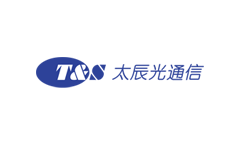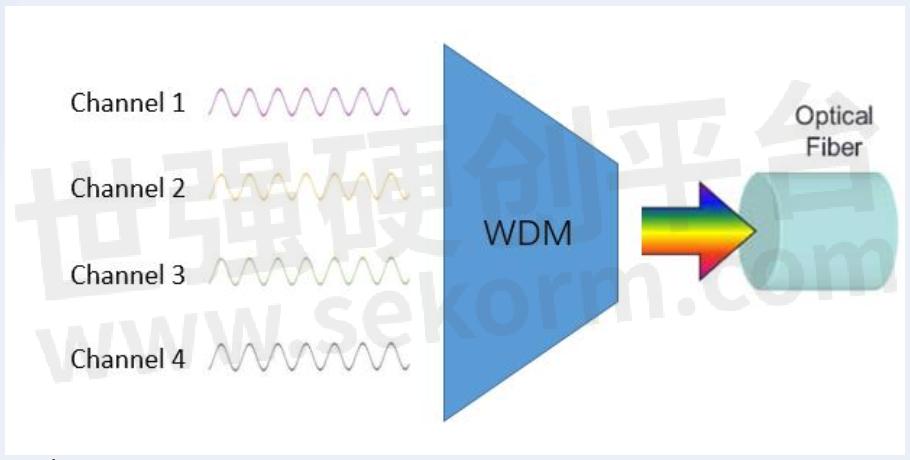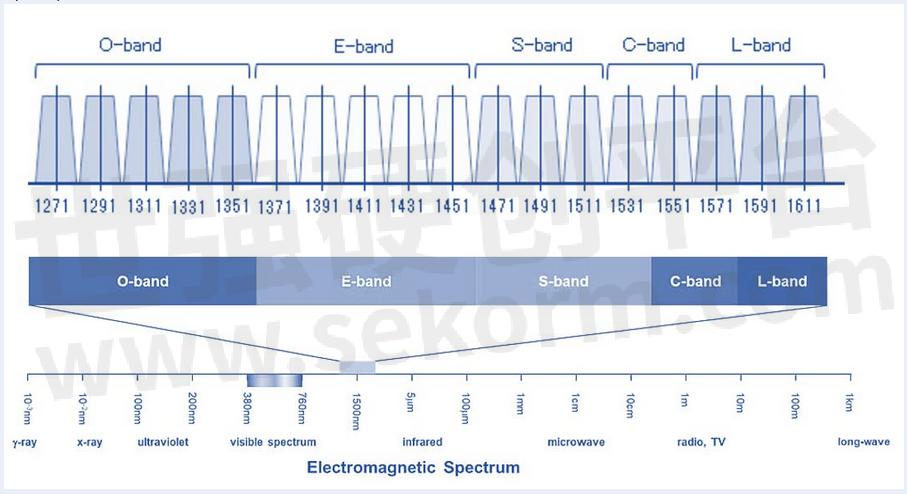What is WDM?




Wavelength Division Multiplexing (WDM) is a technique in fiber optic
transmission for using multiple light wavelengths to send data over the
same medium. Two or more frequencies of light can travel along one
fiber, and multiple signals transmit in an optical waveguide at
different wavelengths.
Fiber-optic transmission systems in the early stage load information to glass fiber with simple light pulses. The "on and off" of the light represents "0" and "1" in the digital world. Basically, from roughly 670nm to 1550nm, the light can be of any wavelength.
Fiber optical communications modems used low-cost LEDs to put near-infrared pulses onto low-cost fiber in the 1980s. The demand for information began to increase afterward, and so did the need for data bandwidth. Early systems delivered 155 Mbps data streams over very long distances with a 1310nm laser solution. However, the capacity was quickly exhausted. Advances in optoelectronic components over the years afterward allowed the design of systems that simultaneously transmitted multiple wavelengths of light over a very single fiber, so as to increase fiber capacity greatly. WDM was then brought to applications. Multiple high-bit-rate data streams of 10Gbps, 40Gbps, 100Gbps, 200Gbps, 400Gbps and more recently 800Gbps, can be multiplexed to a single optical fiber.

Two types of WDM:
Coarse WDM (CWDM): Generally, CWDM is defined by WDM systems with fewer than eight active wavelengths per fiber. CWDM is used for short-reach communications, so it's ok to employ wide-range frequencies with adjacent wavelengths spread far apart. Standardized channel spacing offers room for wavelength drift when lasers' temperature goes up and down during their operation.
Dense WDM (DWDM): DWDM is defined according to frequency. DWDM’s smaller wavelength spacing offers much more channels in a single fiber, while costs more to operate. DWDM is suitable for systems with more than eight active wavelengths over a single fiber.
Vendors have found various techniques for cramming 40, 88, or 96 wavelengths of fixed spacing into the C-band spectrum of fiber with WDM technology. Networks today with high-bandwidth applications and sustained bandwidth growth that are quickly facing capacity exhaustion turn to C+L-band solutions, which develop the L-band spectrum of a fiber to double the fiber capacity.

Optical networks evolve quickly to meet ever-increasing bandwidth demands. To take advantage of these benefits fully requires a flexible-grid line system that accommodates these higher-band channels (800G wavelength for example) that require more than 100GHz.
The next-generation coherent modems are smart and programmable that the modem considers a greater variety of band options, and it allows extremely granular tunability.
Boosted by EDF Amplifiers (EDFAs) and Raman amplification, the reach of these DWDM systems can be extended to thousands of kilometers. Highly precision filters are required to secure a specific wavelength from being interfered with by adjacent wavelengths. Also, DWDM systems must use precision lasers that operate at a constant temperature in order to keep channels on target.
One of the outstanding features of deploying DWDM in a flexible grid photonic system is signal independence. Based on this, many networks previously designed for 10Gbps and 40Gbps are able to carry 200Gbps channels, and many others deployed with flexible grid capability are now carrying 400Gbps and even 800Gbps signals.
T&S offers a wide range of solutions to address customer requirements, from the edge to the core, over a flexible range of platforms.
- |
- +1 赞 0
- 收藏
- 评论 0
本文由出山转载自T&S News,原文标题为:What is WDM?,本站所有转载文章系出于传递更多信息之目的,且明确注明来源,不希望被转载的媒体或个人可与我们联系,我们将立即进行删除处理。
相关推荐
Understanding Fiber Optic Transceiver Modules: Essential Components for Modern Communication
Fiber optic transceiver modules are integral components in modern communication networks, facilitating the transmission of data over long distances at high speeds. These modules combine both transmitter and receiver functionalities into a single unit, allowing for the conversion of electrical signals into optical signals and vice versa. This makes them essential for applications ranging from telecommunication systems to data centers and enterprise networks.
Five Tests to Ensure the Fiber Patch Cord Quality
The quality of fiber patch cords affects the entire fiber-optic link. Each fiber patch cord must be strictly tested before leaving the factory. So what tests will a fiber patch cord manufacturer do to ensure the high quality of patch cords?
Types of Fiber Optic Attenuators
A fiber optic attenuator is a passive device used to reduce the power level of an optical signal in free space or in an optical fiber. They have fixed types, step-variable and continuous-variable types.Although fiber optic attenuators are commonly used in SM (single mode) links, since this is where stronger lasers are used for distance transmission, multimode attenuators are also available.The most common version of attenuators is male-to-female.
TSSP-8525G-XXXC 25G SFP28有源光缆
描述- 该资料介绍了TSSP-8525G-xxxx型号的25GSFP28 Active Optical Cable。这是一种直接连接的光纤组件,具有SFP28连接器,适用于短距离连接,特别适合机架内和相邻机架之间的连接。它支持高达25.78 Gbps的数据速率,并符合SFP28 MSA和IEEE 802.3by 25GBASE-SR标准。
型号- TSSP-8525G-XXXT,TSSP-8525G-XXXC
TSPA-85192-XXXC 10G SFP+有源光缆
描述- 该资料介绍了TSPA-85192-xxxx型号的10G SFP+ Active Optical Cable。这是一种直接连接的光纤组件,具有SFP+连接器,适用于短距离连接,特别适合机架内和相邻机架之间的连接。它支持高达10.3125 Gbps的数据速率,并可在多模光纤系统上运行。
型号- TSPA-85192-XXXC
Coherent Introduced 2x1000mW Dual-Chip Pump Laser Module for Optical Amplification in Optical Networks
Coherent, a leader in pump laser technology for erbium-doped fiber amplifiers (EDFAs) deployed in optical networks, today announced the industry’s first dual-chip pump laser module with up to 1000mW of output power per fiber in a 10-pin butterfly package.
How to Plan the Future 5G Fiber Network?
Based on T&S Communications’s excellent comprehensive capabilities, T&S Communication is dedicated to bringing fiber optical components with superior performance to next-generation communications in a green, pragmatic, and cost-effective manner.
Coherent Reports Significant Advancement in VCSEL Performance for Next-gen AI Networks
Coherent Corp. has made a significant breakthrough in improving the bandwidth of its vertical-cavity surface-emitting laser (VCSEL), paving the way for use in next-generation optical interconnects that will operate at 200 Gbps per lane and thereby enabling optical transceivers with 1.6 Tbps capacity.
Firecomms Fiber Optics for Consumer Network Applications
Firecomms fiber optic solutions are ideal solutions for high-bandwidth triple play networks that require Ethernet data to be transmitted across the home network. Together with Plastic Optical Fiber (POF), Firecomms’ fiber optic transceivers enable quicker, more flexible and cost-effective installations — unique advantage for home builders, installers, content providers, and consumers alike.
What Are the 40G QSFQ+ Fiber Optical Transceivers and Their Differences?
40G networks are widely used in data centers. 40G fiber optical transceivers are the mainstream devices for interconnection between data center equipment. So what are the main types of 40G fiber optical transceivers? What are the differences between them?
Coherent Demonstrated Next-generation Transceiver and Semiconductor Laser Technology for 800G and 1.6T Transmission in AI Networks at ECOC 2023
Coherent Corp., a leader in optical communications components and subsystems,announced that it would demonstrate next-generation transceivers and laser technology for 800G and 1.6T datacom transmission at ECOC 2023 in Glasgow, Scotland, October 2-4, stand #406.
Coherent Introduces Industry’s First 1200 mW Pump Laser Module for Optical Amplification in DWDM Networks
Coherent Corp announced the industry’s first pump laser module with 1200 mW of output power in a 10-pin butterfly package. The 1200 mW pump lasers provide the additional power needed to amplify the larger number of channels supported by these next-gen ultra-broadband optical transmission systems while meeting the stringent reliability requirements of these advanced networks.
电子商城
现货市场
服务
世强深圳实验室提供Robei EDA软件免费使用服务,与VCS、NC-Verilog、Modelsim等EDA工具无缝衔接,将IC设计高度抽象化,并精简到三个基本元素:模块、引脚、连接线,自动生成代码。点击预约,支持到场/视频直播使用,资深专家全程指导。
实验室地址: 深圳 提交需求>




































































































































































































登录 | 立即注册
提交评论